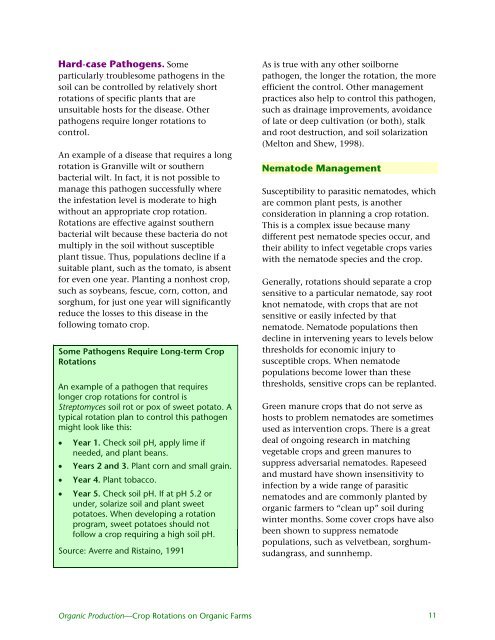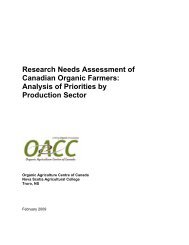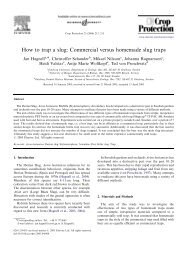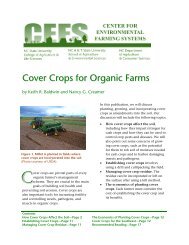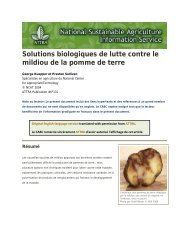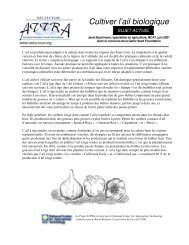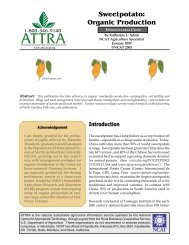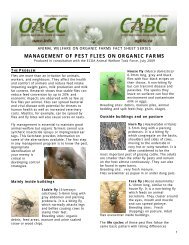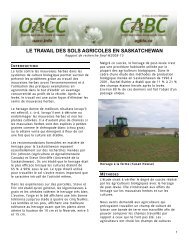You also want an ePaper? Increase the reach of your titles
YUMPU automatically turns print PDFs into web optimized ePapers that Google loves.
Hard-case Pathogens. Someparticularly troublesome pathogens in thesoil can be c<strong>on</strong>trolled by relatively shortrotati<strong>on</strong>s of specific plants that areunsuitable hosts for the disease. Otherpathogens require l<strong>on</strong>ger rotati<strong>on</strong>s toc<strong>on</strong>trol.An example of a disease that requires a l<strong>on</strong>grotati<strong>on</strong> is Granville wilt or southernbacterial wilt. In fact, it is not possible tomanage this pathogen successfully wherethe infestati<strong>on</strong> level is moderate to highwithout an appropriate crop rotati<strong>on</strong>.<str<strong>on</strong>g>Rotati<strong>on</strong>s</str<strong>on</strong>g> are effective against southernbacterial wilt because these bacteria do notmultiply in the soil without susceptibleplant tissue. Thus, populati<strong>on</strong>s decline if asuitable plant, such as the tomato, is absentfor even <strong>on</strong>e year. Planting a n<strong>on</strong>host crop,such as soybeans, fescue, corn, cott<strong>on</strong>, andsorghum, for just <strong>on</strong>e year will significantlyreduce the losses to this disease in thefollowing tomato crop.Some Pathogens Require L<strong>on</strong>g-term <str<strong>on</strong>g>Crop</str<strong>on</strong>g><str<strong>on</strong>g>Rotati<strong>on</strong>s</str<strong>on</strong>g>An example of a pathogen that requiresl<strong>on</strong>ger crop rotati<strong>on</strong>s for c<strong>on</strong>trol isStreptomyces soil rot or pox of sweet potato. Atypical rotati<strong>on</strong> plan to c<strong>on</strong>trol this pathogenmight look like this:• Year 1. Check soil pH, apply lime ifneeded, and plant beans.• Years 2 and 3. Plant corn and small grain.• Year 4. Plant tobacco.• Year 5. Check soil pH. If at pH 5.2 orunder, solarize soil and plant sweetpotatoes. When developing a rotati<strong>on</strong>program, sweet potatoes should notfollow a crop requiring a high soil pH.Source: Averre and Ristaino, 1991As is true with any other soilbornepathogen, the l<strong>on</strong>ger the rotati<strong>on</strong>, the moreefficient the c<strong>on</strong>trol. Other managementpractices also help to c<strong>on</strong>trol this pathogen,such as drainage improvements, avoidanceof late or deep cultivati<strong>on</strong> (or both), stalkand root destructi<strong>on</strong>, and soil solarizati<strong>on</strong>(Melt<strong>on</strong> and Shew, 1998).Nematode ManagementSusceptibility to parasitic nematodes, whichare comm<strong>on</strong> plant pests, is anotherc<strong>on</strong>siderati<strong>on</strong> in planning a crop rotati<strong>on</strong>.This is a complex issue because manydifferent pest nematode species occur, andtheir ability to infect vegetable crops varieswith the nematode species and the crop.Generally, rotati<strong>on</strong>s should separate a cropsensitive to a particular nematode, say rootknot nematode, with crops that are notsensitive or easily infected by thatnematode. Nematode populati<strong>on</strong>s thendecline in intervening years to levels belowthresholds for ec<strong>on</strong>omic injury tosusceptible crops. When nematodepopulati<strong>on</strong>s become lower than thesethresholds, sensitive crops can be replanted.Green manure crops that do not serve ashosts to problem nematodes are sometimesused as interventi<strong>on</strong> crops. There is a greatdeal of <strong>on</strong>going research in matchingvegetable crops and green manures tosuppress adversarial nematodes. Rapeseedand mustard have shown insensitivity toinfecti<strong>on</strong> by a wide range of parasiticnematodes and are comm<strong>on</strong>ly planted byorganic farmers to “clean up” soil duringwinter m<strong>on</strong>ths. Some cover crops have alsobeen shown to suppress nematodepopulati<strong>on</strong>s, such as velvetbean, sorghumsudangrass,and sunnhemp.<strong>Organic</strong> Producti<strong>on</strong>—<str<strong>on</strong>g>Crop</str<strong>on</strong>g> <str<strong>on</strong>g>Rotati<strong>on</strong>s</str<strong>on</strong>g> <strong>on</strong> <strong>Organic</strong> <strong>Farms</strong> 11


